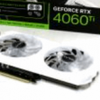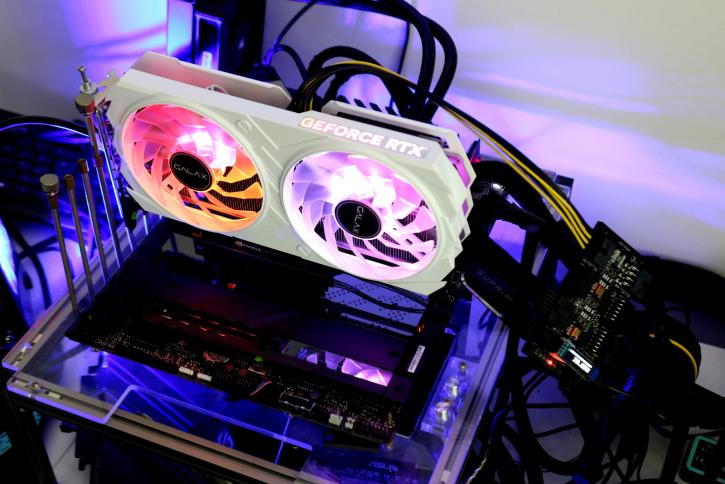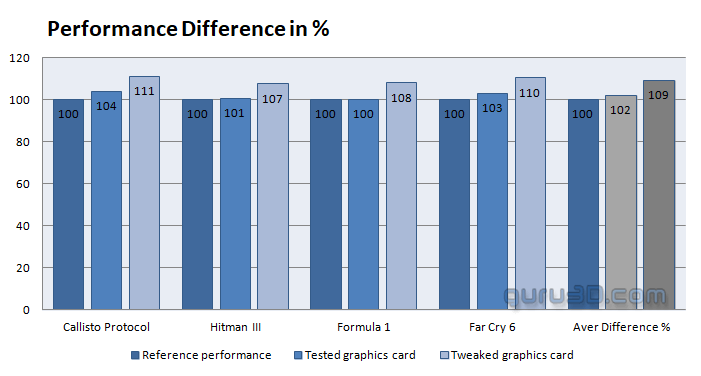Final words and conclusion
Analysis
The Galax EX White edition graphics card offers a satisfactory level of Full HD gaming performance, paired with a design of moderate aesthetic appeal with a reasonably muted acoustic operation. A notable downside of this product range is the soaring pricing level, as determined by NVIDIA. This particular card aligns with the manufacturer's suggested retail price (MSRP), although it remains costly. The EX White edition illustrates a marginal performance enhancement of around 2% compared to the reference model, showcasing GALAX's aptitude for crafting visually pleasing and low-noise graphics cards. For those who wish to optimize the card's capacity further, there's the possibility to manually adjust its settings to potentially improve performance by an estimated 9% compared to reference performance.
Performance
The GeForce RTX 4060 Ti graphics card is engineered to provide reliable gaming performance and accurate rendering at Full HD (FHD) resolutions, and it remains proficient up to Quad HD (QHD) resolutions. Notably, as you reach QHD, the need for features like Deep Learning Super Sampling 3 (DLSS 3 + Frame Generation) grows, particularly when ray tracing is enabled. The card benefits from the incorporation of an advanced generation of Ray Tracing and Tensor cores, which enhances these capabilities. Nonetheless, its 8GB memory could be limited, especially considering the demands of DLSS3 Frame generation, which heavily utilises VRAM. A larger memory capacity of 12GB and a broader memory bus could potentially optimize the card's performance further.
Cooling & noise levels
In terms of operation, the graphics card demonstrates a power consumption slightly at roughly 150 watts at full load, averaging around 135W as per our measurements. This power intake corresponds directly to the heat produced by the GPU. The card maintains a noise level of approximately ~37 dBA, which can be classified as silent but slightly noticeable. During rigorous tasks, the card's temperature may rise to roughly 60-65 °C. The fluctuation in this temperature can be attributed to the effectiveness of the airflow within the computer case. The thermal imaging analysis conducted via FLIR, demonstrates no substantial issues regarding heat dissipation.
Coil whine
Coil whine is a phenomenon that may affect any graphics card, the severity of which can vary. When the graphics card is operating at high framerates, the sound may be faintly perceptible, but it is typically muted to a point of near inaudibility within a closed computer case. The noise tends to recede into the ambient soundscape, making it largely unnoticeable. Specifically regarding this graphics card, it has been observed to produce only minimal coil whine.
Pricing
NVIDIA has introduced this new graphics card series priced at $399, which does not bring affordability back to the market. This price point is reminiscent of the 3060 Ti, indicating a shift from the inflated prices seen during the cryptocurrency mining era. Although the prices have remained higher than expected for unknown reasons, the card offers enough performance for Full HD resolution. With the help of a DLSS assist, it can even deliver good results. The Nvidia GeForce RTX 4060 Ti Founders Edition will include 8GB of memory, with an option for a 16GB model. As for the GeForce RTX 4060, Nvidia has not released any comments yet. However, it's confirmed that the entry-level Ada Lovelace graphics card for gaming enthusiasts will debut at $299 USD, exclusive of VAT.
- GeForce RTX 4060 Ti 8GB: Will be available from May 24 for $399 USD
- GeForce RTX 4060 Ti 16GB: Will be released in July for $499 USD
- GeForce RTX 4060 8GB: Will also be released in July for $299 USD
Tweaking
You can enhance your GPU's performance by fine-tuning the clock frequency and memory speed. A clock frequency increase of approximately +200 MHz is possible with a bit of added voltage. Consequently, you can anticipate your GPU boost clock frequency around the ~3000MHz range, contingent on the dynamic frequencies of different game titles, furthermore, by modifying the memory speed to 21 Gbps. Add to that a power limiter increase of up-to %14 ... Accumulated, you can expect a ~9% performance improvement in demanding GPU scenarios compared to the reference (baseline) performance.
Overall the card is 1% faster than founders edition performance, but tweaked is 9% faster.
Conclusion
Galax has launched an ably crafted graphics card that promises a steady gaming experience in Full HD and with DLSS3/FG and even WQHD monitor resolution. However, it does carry certain drawbacks. The main issues of this series lie in its cost, 8GB memory, and a minimal performance increase compared to the previous generation, much to the dismay of many users. Even though the cryptocurrency mining hype has settled, elevated prices persist. The question arises if it's justified for a card aimed at the Full HD segment. We also feel that NVIDIA is leaning too much on technologies like DLSS3 and frame generation, which created game dependencies, and especially at Full HD, you're going to have to forfeit on image quality. Moreover, there's a debate about whether entry and mainstream level products actually require premium designs, luckily this remains to be an MSRP product. From an objective perspective, the GALAX GeForce RTX 4060 Ti EX White offers tolerable acoustic levels at approximately 37 DBa. Regardless of its marginal 2% performance boost over the founder's edition, the card series could still appeal to those prioritizing a quieter operation and a visually pleasing interior for their computer case with its white design and nice looking RGB fans.
Additionally, the card presents significant overclocking potential, exhibiting a further 9% performance increase from the reference performance. To conclude, there is no question regarding the quality of the product; rather, the problem arises from the product's high price range, which doesn't seem to match up towards a mainstream positioning. Ideally, this card series should have come with a 12GB, 192-bit memory and a price tag of $250. Unfortunately, NVIDIA made a different decision.
- Download NVIDIA GeForce drivers
- Sign up to receive a notification when we publish a new article.
- Or go back to Guru3D's front page
- Hilbert, LOAD"*",8,1.



